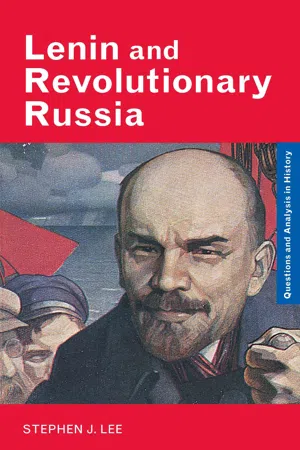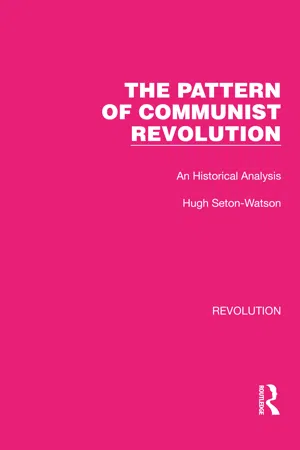Bolshevik
The Bolsheviks were a faction of the Russian Social Democratic Labour Party, led by Vladimir Lenin, that eventually seized power in the October Revolution of 1917. They advocated for a revolutionary overthrow of the existing social and political order, and their rise to power marked the beginning of communist rule in Russia.
6 Key excerpts on "Bolshevik"
- eBook - ePub
- Stephen J. Lee(Author)
- 2008(Publication Date)
- Routledge(Publisher)
...This is also highly controversial. According to the official Soviet version, the period 1905–14 was one of patient consolidation or purposeful regrouping. The Bolsheviks consolidated the Party Central Committee, launched a new paper, Pravda, and sat as a separate party in the new Duma. Under Lenin’s leadership, ‘The Bolshevik Party headed all the manifestations and forms of the struggle of the proletariat.’ The wave of strikes throughout Russia between 1912 and 1914 was the response to the Bolshevik urge ‘to intensify the revolutionary struggle, which was shaking the foundations of Tsarism’. The Bolsheviks inspired first of all the protests in the Lena goldfields (1912) and then a general strike in St Petersburg. The collapse of the Tsarist regime was by now inevitable. 9 The outbreak of the First World War provided a further opportunity, which Lenin successfully interpreted and exploited. While Social Democrats everywhere were divided over the question of whether to support the war effort, the Bolsheviks were resolute. They ‘marched in the forefront of the fighters for Marxism and rallied the revolutionary forces in the international working-class movement’. By contrast, the ‘opportunists’ collaborated with the various governments while those who were undecided – the ‘centre’ – criticised the opportunists but did not make a clean break with them. The leaders of this trend were ‘Karl Kautsky in Germany and Leon Trotsky in Russia’. Hence ‘The Bolsheviks were the only Party which remained true to socialism and internationalism and drew up a revolutionary programme of struggle against the war.’ Guided by Lenin’s writings, the Bolsheviks managed to turn the ‘imperialist war’ into a ‘civil war’; they ‘headed strikes’, turning them into ‘political actions against tsarism.’ They also organised dissent and mutinies within the army, and established links with the peasantry and the different national groups. 10 Several comments can be made on this Soviet version...
- eBook - ePub
Revolutionary Russia
New Approaches to the Russian Revolution of 1917
- Rex A. Wade, Rex A. Wade(Authors)
- 2004(Publication Date)
- Routledge(Publisher)
...The October (or Bolshevik) Revolution in particular was seen as a political seizure of power (often termed a coup d’état) planned and engineered by Lenin, largely divorced from its broader political, social, and cultural context. For Soviet historians, this flowed naturally from the cult of Lenin worship as well as the demands of the Communist Party and Soviet state. Curiously enough, this Lenin-centered approach was congenial to anti-Communists, Russian and foreign, because it allowed an interpretation which, by largely ignoring other, especially social, factors, cast the Bolsheviks as leaders of a coup with no popular support and thus illegitimate. In either approach, the “masses” were largely absent or inert, manipulated (or led) by unscrupulous (or farsighted) political figures, most importantly Lenin and the Bolsheviks. At the best the masses were “spontaneous,” an ill-defined chorus chanting mindlessly in the background. They had no agency, no characterization as comprehensible interest groups or as actors. Institutionally, these histories focused primarily on the Bolshevik Party and Lenin’s ideas and leadership, and secondarily on the Provisional Government formed after the overthrow of the monarchy (and within that on Alexander Kerensky and Pavel Miliukov, its two most prominent figures). Often the history of the revolution was reduced to Lenin’s actions and to the assumption that what Lenin in his writings before and during 1917 said should happen, did happen. The story was framed to explain Communism and the Soviet Union, and thus focused on Lenin, the Bolsheviks, and their ideology. The difference was that Soviet histories saw that revolution as good and most Western historians saw it as bad...
- eBook - ePub
- Richard H Hudelson(Author)
- 2019(Publication Date)
- Routledge(Publisher)
...Mesmerized by the sequential-stages view of history, according to which Russia was slated for a bourgeois revolution, the central committee of the Bolsheviks in St. Petersburg rejected Lenin’s position by a vote of thirteen to two. But Lenin pressed his position. He argued that with the development of the soviets real power had come into the hands of the workers and poor peasants and that it would be a counterrevolutionary step at this point to relinquish power to the provisional government, which supported the interests of the bourgeoisie. Gradually Lenin won over the Bolshevik leadership. The new Bolshevik position struck a responsive chord within the soviets and within Russia as a whole. By July party membership, which had stood at 24,000 in February, had increased to 240,000. In St. Petersburg popular enthusiasm for the revolutionary cause led the Bolsheviks to support a premature uprising that failed. Apparently defeated, Lenin was forced to go into hiding. But by late September, after a failed right-wing military coup, the Bolsheviks had won a majority in the St. Petersburg Soviet, where Lenin’s new ally, Leon Trotsky, had been elected president of the Soviet. On October 25 (November 7 on the new calendar), over the continuing objections of some members of the Bolshevik central committee, the Bolsheviks seized power. The Bolsheviks came to power on the basis of the slogan “bread, peace, and land.” Consistent with his early thoughts on the key role of the peasantry, Lenin acted quickly to secure peasant support for Bolshevik rule. On the morning of October 26, the first day of Bolshevik power, the new government abolished private ownership of land but granted the peasants the right to occupy and use the land. In general, the new government proclaimed its socialist principles but did not aim at the immediate socialization of the economy...
- eBook - ePub
The Pattern of Communist Revolution
An Historical Analysis
- Hugh Seton-Watson(Author)
- 2022(Publication Date)
- Routledge(Publisher)
...The task of himself and his party was to ensure that the second triumphed, and thus that the gap between the bourgeois and the proletarian revolutions should be made as short as possible. The correct tactic for the Bolsheviks was therefore to deny support to the Provisional Government and to do everything to strengthen the soviets in the capitals and the provinces. The correct slogan must be ‘All power to the soviets!’ This conception of the revolutionary role of the soviets and the jump straight from the bourgeois to the proletarian revolution was linked in Lenin’s mind with the ideas that the Russian revolution must become the starting-point for socialist revolutions in advanced European countries, and that a new International, based upon a true vanguard of the international proletariat, must be founded, in place of the now defunct Second International, to co-ordinate the European revolutions. 1 Once he had returned to Russia in April, having passed from Switzerland through Germany to Sweden with the permission of the German General Staff, Lenin immediately and energetically advocated these policies. The Bolshevik leaders whom he found in control of the party—Kamenev, Stalin and Muranov—were astonished at his views, but were soon converted to them. Lenin’s tactics with regard to the soviets must be considered not only on the level of revolutionary doctrine, as summarised above, but also on the level of practical politics. The great practical merit of the soviets from Lenin’s point of view was that they represented not the trained politicians but the untrained masses of the factories and the armed forces. Excluded from political life under the old regime, the inexperienced, primitive and largely illiterate masses were being brought for the first time into political life through the soviets...
- eBook - ePub
- Alan Wood(Author)
- 2004(Publication Date)
- Routledge(Publisher)
...Much of this research demonstrates that after the collapse of the autocracy, rather than unifying in some kind of common purpose, Russian society became increasingly polarized along class lines, with the workers, peasants and conscript soldiers becoming more and more alienated from a government which continued to defend the interests of the propertied classes. Lenin’s slogan of ‘All Power to the Soviets’, adopted in April and revived on the eve of October, simply articulated the feeling of the hoi polloi that a government of the Soviets – the elected representatives of the plebeian masses – rather than a government of self-appointed middle- and upper-class conservative politicians and financially privileged businessmen was the preferred alternative. The American historian, Ronald Suny, has put it as follows: The Bolsheviks came to power, not because they were superior manipulators or cynical opportunists, but because their policies, as formulated by Lenin in April and shaped by the events of the following months, placed them at the head of a genuinely popular movement. On the other hand, another prominent American scholar, Richard Pipes, has recently written: The Russian Revolution was made neither by the forces of nature nor by anonymous masses but by identifiable men pursuing their own advantages. The controversy over the origins of the Russian Revolution, therefore, still continues unabated, and no less acrimoniously since the disintegration of the State which it engendered. Inside Russia itself, the breakdown of Communist Party control over the historiography of the Revolution has opened up a new vista of opportunities and created a whole gamut of fresh interpretations which, based on recently released archive material, offers exciting prospects for further study of 1917 and its antecedents. During the late 1980s, it became increasingly apparent that the traditional Marxist-Leninist orthodoxy was no longer acceptable...
- eBook - ePub
Red Advance, White Defeat
Civil War in South Russia 1919–1920
- Peter Kenez(Author)
- 2008(Publication Date)
- New Academia(Publisher)
...No revolutionary before Lenin had paid comparable attention to the mundane needs of building a party machinery. Lenin always struggled against the anarchic element in Russian socialism, and he feared and distrusted spontaneous action. In his opinion the success of the revolution depended not so much on the workers themselves as on the cohesion and skill of the Party. 1 From their experience in revolutionary underground work against the tsarist regime, the Bolsheviks had learned the same lesson: in order to succeed, the Party needed discipline and tight organization; In a period of anarchy and confusion a small group of dedicated people can accomplish remarkable tasks. In Russia, it was only the Bolsheviks who were predisposed by their intellectual and political traditions to act on the basis of this understanding. Of course, the Party was not yet afflicted by Stalinist conformity. The Bolsheviks were members of the international socialist community, and their theoretical heritage, together with autocratic elements, included a commitment to democracy. Later, when the requirements of democracy and the need for discipline collided, the Bolsheviks would again and again choose discipline. But at the outbreak of the Civil War the Party was still creating itself, and its future was far from predetermined. In the period of underground struggle, Lenin had frequently removed those comrades who dared to disagree with him on important matters. However, the ever-pragmatic leader realized that the needs of the Party in 1917 were not the same as when it had been a small band of revolutionaries. He knew that even the occasionally unruly followers could make important contributions, and was therefore willing to overlook “errors” and forgive past “mistakes.” The chaotic circumstances of the Revolution also loosened discipline. As a result, the Bolshevik Party of 1917-1921 was a more heterogeneous organization than at any other period of its history...





